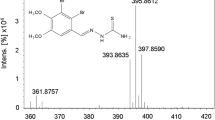Summary
A specific, sensitive and reliable HPLC method for the determination of doxorubicin (DX), epirubicin (epiDX) and their known fluorescent metabolites [doxorubicinol (DXol), epirubicinol (epiDXol) 7-deoxy-adriamycinone (metabolite C), adriamycinone (metabolite D), 7-deoxy-13-dihydro-adriamycinone (metabolite E), 13-dihydro-adriamycinone (metabolite F), 4'-O-β-d-glucuronyl-4'-epiDX (metabolite G) and 4'-O-β-d-glucuronly 13-dihydro-4'-epiDX (metabolite H)] in biological fluids (human plasma, bile and urine) has been developed and tested. Plasma samples were solid-phase-extracted (C18-bonded silica cartridges). Urine and bile samples were injected directly after the addition of the internal standard and dilution with 0.3 M phosphoric acid. Complete separation of unchanged drugs and metabolites was achieved with a mobile phase consisting of 75.6% 10 mM KH2PO4 and 24.4% CH3CN (the pH of the solution was adjusted to 4.3 with 0.03 M H3PO4) at a flow rate of 1.5 ml/min. For the analyses we used a cyanopropyl chromatographic column (25 cmx4.6 mm i.d.; particle size 5 μm) and fluorescence detection with excitation wavelength set at 470 nm and emission at 580 nm. Sensitivity was better than 0.3 ng/ml for all substances analysed. The mean absolute recovery of unchanged drugs and metabolites was between 88.3% (metabolite E) and 98.92% (metabolite G). Intraand interassay precisions (plasma samples) were better than 10.6% and 13.0%.
Similar content being viewed by others
References
Arcamone F, Penco S, Vigevani A, Redaelli S, Franchi G, Di Marco A, Casazza AM, Dasdia T, Formelli F, Necco A, Soranzo C (1975) Synthesis and antitumor properties of new glycosides of daunomycinone and adriamycinone. J Med Chem 18:703–707
Benjamin RS, Riggs CE, Bachur NR (1977) Plasma pharmacokinetics of adriamycin and its metabolites in humans with normal hepatic and renal function. Cancer Res 37:1416–1420
Brenner DE, Galloway S, Cooper J, Noone R, Hande R (1985) Improved high-performance liquid chromatographic assay of doxorubicin: detection of circulating aglycones in human plasma and comparision with thin-layer chromatography. Cancer Chemother Pharmacol 14:139–145
Camaggi CM, Strocchi E, Tamassia V, Martoni A, Giovannini M, Iafelice G, Canova N, Marraro D, Martini A, Pannuti F (1982) Pharmacokinetic studies of 4'epidoxorubicin in cancer patients with normal and impaired renal functions and with hepatic metastases. Cancer Treat Rep 66:1819–1824
Camaggi CM, Strocchi E, Martoni A, Angelelli B, Comparsi R, Pannuti F (1985) Epirubicin plasma and blood pharmacokinetics after single IV bolus in advanced cancer patients. Drugs Exp Clin Res 11:285–294
Camaggi CM, Comparsi R, Strocchi E, Testoni F, Pannuti F (1988) Epirubicin and doxorubicin comparative metabolism and pharmacokinetics. A cross-over study. Cancer Chemother Pharmacol 21:221–228
Eksborg S, Ehrsson CE, Andersson I (1979) Reversed-phase liquid chromatographic determination of plasma levels of adriamycin and adriamycinol. J Chromatr 164:479–486
Moro E, Jannuzzo MG, Ranghieri M, Stegnjaich S, Valzelli G (1982) Determination of 4'-epi-doxorubicin and its 13-dihydroderivative in human plasma by high-performance liquid chromatography with fluorescence detection. J Chromatr 230: 207–210
Pierce RN, Jatlow PL (1979) Measurement of adriamycin (doxorubicin) and its metabolites in human plasma using reversed-phase high-performance liquid chromatography and fluorescence detection. J Chromatr 164:471–478
Quattrone AJ, Ranney DF (1980) Simplified toxicologic monitoring of adriamycin, its major metabolites and nogalamycin by reverse-phase high pressure chromatography. J Anal Toxicol 4:12–15
Robert J (1980) Extraction of anthracyclines from biological fluids for HPLC evaluation. J Liquid Chromatogr 3: 1561–1563
Van Lancker MA, Bellemans LA, Leenheer AP (1986) Quantitative determination of low concentrations of adriamycin in plasma and cell cultures, using a volatile extraction buffer. J Chromatr 374:415–420
Young CW (1984) Epirubicin: a therapeutically active doxorubicin analogue with reduced cardiotoxicity. In: Bonadonna G (ed) Advances in anthracycline chemotherapy: epirubicin. Masson, Milan, pp 183–188
Author information
Authors and Affiliations
Additional information
Supported in part by contract CNR, no. 85.02282.44 (Progetto Finalizzato Oncologia)
Rights and permissions
About this article
Cite this article
Camaggi, C.M., Comparsi, R., Strocchi, E. et al. HPLC analysis of doxorubicin, epirubicin and fluorescent metabolites in biological fluids. Cancer Chemother. Pharmacol. 21, 216–220 (1988). https://doi.org/10.1007/BF00262773
Received:
Accepted:
Issue Date:
DOI: https://doi.org/10.1007/BF00262773




